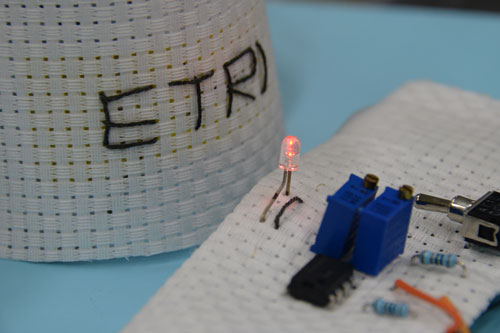| Posted: Oct 13, 2015 |
Graphene-coated 'e-textile' detects noxious gases
(Nanowerk News) Scientists in Korea have developed wearable, graphene-coated fabrics that can detect dangerous gases present in the air, alerting the wearer by turning on an LED light ("Ultrasensitive and Highly Selective Graphene-Based Single Yarn for Use in Wearable Gas Sensor").
|
|
The researchers, from the Electronics and Telecommunications Research Institute and Konkuk University in the Republic of Korea, coated cotton and polyester yarn with a nanoglue called bovine serum albumin (BSA). The yarns were then wrapped in graphene oxide sheets.
|
 |
| The graphene-coated yarn sensor. (Image: ETRI)
|
|
Graphene is an incredibly strong one-atom-thick layer of carbon, and is known for its excellent conductive properties of heat and electricity. The graphene sheets stuck very well to the nanoglue—so much so that further testing showed the fabrics retained their electrical conducting properties after 1,000 consecutive cycles of bending and straightening and ten washing tests with various chemical detergents. Finally, the graphene oxide yarns were exposed to a chemical reduction process, which involves the gaining of electrons.
|
|
The reduced-graphene-oxide-coated materials were found to be particularly sensitive to detecting nitrogen dioxide, a pollutant gas commonly found in vehicle exhaust that also results from fossil fuel combustion. Prolonged exposure to nitrogen dioxide can be dangerous to human health, causing many respiratory-related illnesses. Exposure of these specially-treated fabrics to nitrogen dioxide led to a change in the electrical resistance of the reduced graphene oxide.
|
|
The fabrics were so sensitive that 30 minutes of exposure to 0.25 parts per million of nitrogen dioxide (just under five times above the acceptable standard set by the U.S. Environmental Protection Agency) elicited a response. The fabrics were three times as sensitive to nitrogen dioxide in air compared to another reduced graphene oxide sensor previously prepared on a flat material.
|
|
The new technology, according to the researchers, can be immediately adopted in related industries because the coating process is a simple one, making it suitable for mass production. It would allow outdoor wearers to receive relevant information about air quality. The materials could also be incorporated with air-purifying filters to act as “smart filters” that can both detect and filter harmful gas from air.
|
|
“This sensor can bring a significant change to our daily life since it was developed with flexible and widely used fibers, unlike the gas sensors invariably developed with the existing solid substrates,” says Dr. Hyung-Kun Lee, who led this research initiative.
|

